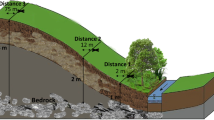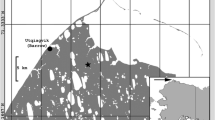Abstract
Microbial communities at soil-stream interfaces may be particularly important in regulating amounts and forms of nutrients that leave upland soils and enter stream ecosystems. While microbial communities are thought to be responsible for key nutrient transformations within near-stream sediments, there is relatively little mechanistic information on factors that control microbial activities in these areas. In this study, we examine the roles of dissolved organic carbon (DOC) vs. particulate organic carbon (POC) as potential controls on rates of bacterial productivity (measured as incorporation of [3H]thymidine into bacterial DNA) and amounts of bacterial biomass (measured as fatty acid yield) in sediments along a transect perpendicular to a soil–stream interface. We hypothesized that spatial patterns in bacterial productivity would vary in response to strong and persistent patterns in pore-water concentrations of DOC that were observed along a soil-stream transect throughout a 2-year period. Our results did not support the existence of such a link between pore-water DOC and bacterial productivity. In contrast, we found bacterial productivity and biomass were related to small-scale spatial variations in sediment POC on 3 of 4 sample dates. While our results indicate that total bacterial productivity in near-stream sediments is not consistently linked to spatial variations in pore-water DOC, it is likely that DOC and POC are not mutually exclusive and the relative contribution of DOC and POC to sedimentary microbes varies temporally and spatially in different riparian habitats.
Similar content being viewed by others
References
Bird, D. F. & C. M. Duarte, 1989. Bacteria-organic matter relationship in sediments: a case of spurious correlation. Can. J. Fish. aquati. Sci. 46: 904–908.
Chrzanowski, T. H., K. Simek, R. H. Sada & S. Williams, 1993. Estimates of bacterial growth rate constants from thymidine incorporation and variable conversion factors. Microb. Ecol. 25: 121–130.
Cole, J. J., S. Findlay & M. L. Pace, 1988. Bacterial production in fresh and salt water ecosystems: a cross-system overview. Mar. Ecol. Prog. Ser. 43: 1–10.
Dobbs, F. C. & R. H. Findlay, 1993. Analysis of microbial lipids to determine biomass and detect the response of sedimentary microorganisms to disturbance. In P. F. Kemp, B. F. Sherr, E. B. Sherr & J. J. Cole (eds), Handbook of Methods in Aquatic Microbial Ecology. Lewis Publishers: 347–358.
Dosskey, M. G. & P. M. Bertsch, 1994. Forest sources and pathways of organic matter transport to a blackwater stream: a hydrologic approach. Biogeochemistry 24: 1–19.
Fallon, R. D. & C. W. Boylen, 1990. Bacterial production in freshwater sediments: cell specific versus system measurements. Microb. Ecol. 19: 53–62.
Fiebig, D., 1997. Microbiological turnover of amino acids immobilized from groundwater discharged through hyporheic sediments. Limnol. Oceanogr. 42: 763–768.
Fiebig, D. & J. Marxsen, 1992. Immobilization and mineralization of dissolved free amino acids by stream-bed biofilms. Freshwat. Biol. 28: 129–140.
Findlay, S., 1993. Thymidine incorporation into DNA as an estimate of sediment bacterial production. In P. F. Kemp, B. F. Sherr, E. B. Sherr & J. J. Cole (eds), Handbook of Methods in Aquatic Microbial Ecology. Lewis Publishers: 505–508.
Findlay, S. E. G., J. L. Meyer & R. T. Edwards, 1984. Measuring bacterial production via rate of incorporation of [3H]thymidine into DNA J. Microbiol. Meth. 2: 57–72.
Findlay, S. & W. V. Sobczak, 1996. Variability in removal of dissolved organic carbon in hyporheic sediments. J. n. am. Benthol. Soc. 15: 35–41.
Findlay, S., D. Strayer, C. Goumbala & K. Gould, 1993. Metabolism of streamwater dissolved organic carbon in the shallow hyporheic zone. Limnol. Oceanogr. 38: 1493–1499.
Fischer, H., M. Pusch & J. Schwoerbel, 1996. Spatial distribution and respiration of bacteria in stream-bed sediments. Arch. Hydrobiol. 137: 281–300.
Groffman, P. M., A. J. Gold & R. C. Simmons, 1992. Nitrate dynamics in riparian forests: microbial studies. J. envir. Qual. 21: 666–671.
Haack, S. K., T. M. Burton & K. Ulrich, 1988. Effects of whole-tree harvest on epilithic bacterial populations in headwater streams. Microb. Ecol. 16: 165–181.
Haack, S. K., H. Garchow, D. A. Odelson, L.J. Forney & M. J. Klug, 1994. Accuracy, reproducibility, and interpretation of fatty acid methyl ester profiles of model bacterial communities. Appl. envir. Microbiol. 60: 2483–2493.
Hanson, G. C., P. M. Groffman & A. J. Gold, 1994. Symptoms of nitrogen saturation in a riparian wetland. Ecol. Applic. 4: 750–756.
Hedin, L. O., 1990. Factors controlling sediment community respiration in woodland stream ecosystems. Oikos 57: 94–105.
Hedin, L. O. & M. B. Brown, 1994. Watershed-level coupling of nitrogen and sulfur in a heterogeneous landscape. Verh. int. Ver. Limnol. 25: 1477–1482.
Hedin, L. O., J. C. von Fischer, N. E. Ostrom, B. P. Kennedy, M. G. Brown & G. P. Robertson, 1998. Thermodynamic constraints on nitrogen transformations and other biogeochemical processes at soil-stream interfaces. Ecology 79: 684–703.
Hendricks, S. P., 1996. Bacterial biomass, activity, and production within the hyporheic zone of a north-temperate stream. Arch. Hydrobiol. 136: 467–487.
Jones, J. B., Jr., S. G. Fisher & N. B. Grimm, 1995. Vertical hydrologic exchange and ecosystem metabolism in a Sonoran Desert stream. Ecology 76: 942–952.
Kaplan, L. A. & J. D. Newbold, 1993. Biogeochemistry of dissolved organic carbon entering streams. In T. E. Ford (ed.), Aquatic Microbiology: an Ecological Approach. Blackwell Scientific Publications: 139–166.
Kaplan, L. A., T. L. Bott & J. K. Bielicki, 1992. Assessment of [3H]thymidine incorporation into DNA as a method to determine bacterial productivity in stream bed sediments. Appl. envir. Microbiol. 58: 3614–3621.
Likens, G. E., 1984. Beyond the shoreline: a watershed-ecosystem approach. Verh. int. Ver. Limnol. 22: 1–22.
Marxsen, J., 1996. Measurement of bacterial production in streambed sediments via leucine incorporation. FEMS Microb. Ecol. 21: 313–325.
McClain, M. E., J. E. Richey & T. P. Pimentel, 1994. Groundwater nitrogen dynamics at the terrestrial-lotic interface of a small catchment in the Central Amazon Basin. Biogeochemistry 27: 113–127.
McDowell, W. H., 1985. Kinetics and mechanisms of dissolved organic carbon retention in a headwater stream. Biogeochemistry 1: 329–352.
McDowell, W. H. & G. E. Likens, 1988. Origin, composition, and flux of dissolved organic carbon in the Hubbard Brook Valley. Ecol. Monogr. 58: 177–195.
McKnight, D. M., K. E. Bencala, G. W. Zellweger, G. R. Aiken, G. L. Feder & K. A. Thorn, 1992. Sorption of dissolved organic carbon by hydrous aluminum andiron oxides occurring at the confluence of deer creek with the Snake River, Summit County, Colorado. Envir. Sci. Technol. 26: 1388–1396.
Metzler, G. M. & L. A. Smock, 1990. Storage and dynamics of subsurface detritus in a sand-bottomed stream. Can. J. Fish. aquat. Sci. 47: 588–594.
Moriarty, D., 1986. Measurement of bacterial growth rates in aquatic systems from rates of nucleic acid synthesis. In K. C. Marshall (ed.), Advances in Microbial Ecology, Vol. 9. Plenum Press: 245.
Moriarty, D. & P. Pollard, 1981. DNA synthesis as a measure of bacterial productivity in seagrass sediments. Mar. Ecol. Prog. Ser. 5: 151–156.
Pollard, P. C. & D. Moriarty, 1984. Validity of the tritiated thymidine method for estimating bacterial growth rates: measurement of isotope dilution during DNA synthesis. Appl. envir. Microbiol. 48: 1076–1083.
Pusch, M., 1996. The metabolism of organic matter in the hyporheic zone of a mountain stream, and its spatial distribution. Hydrobiologia 323: 107–118.
Pusch, M. & J. Schwoerbel, 1994. Community respiration in hyporheic sediments of a mountain stream (Steina, Black Forest). Arch. Hydrobiol. 130: 35–52.
Sander, B. C. & J. Kalff, 1993. Factors controlling bacterial production in marine and freshwater sediments. Microb. Ecol. 26: 79–99.
Simon, M. & F. Azam, 1989. Protein content and protein synthesis rates of planktonic marine bacteria. Mar. Ecol. Prog. Ser. 51: 201–213.
Thurman, E. M., 1985. Organic geochemistry of natural waters. Martinus Nijhoff/Dr W. Junk Publishers, The Hague.
Vervier, P., M. Dobson & G. Pinay, 1993. Role of interaction zones between surface and ground waters in DOC transport and processing: considerations for river restoration. Freshwat. Biol. 29: 275–284.
Vestal, J. R. & D. C. White, 1989. Lipid analysis in microbial ecology. BioScience 39: 535–541.
Wetzel, R. G. & B. A. Manny, 1977. Seasonal changes in particulate and dissolved organic carbon and nitrogen in a hardwater stream. Arch. Hydrobiol. 80: 20–39.
Wetzel, R. G., 1990. Land-water interfaces: metabolic and limnological regulators. Verh.int. Ver. Limnol. 24: 6–24.
White, P. A., J. Kalff, J. B. Rasmussen & J. M. Gasol, 1991. The effect of temperature and algal biomass on bacterial production and specific growth rate in freshwater and marine habitats. Microb. Ecol. 21: 99–118.
Author information
Authors and Affiliations
Corresponding author
Rights and permissions
About this article
Cite this article
Sobczak, W.V., Hedin, L.O. & Klug, M.J. Relationships between bacterial productivity and organic carbon at a soil—stream interface. Hydrobiologia 386, 45–53 (1998). https://doi.org/10.1023/A:1003583813445
Issue Date:
DOI: https://doi.org/10.1023/A:1003583813445




